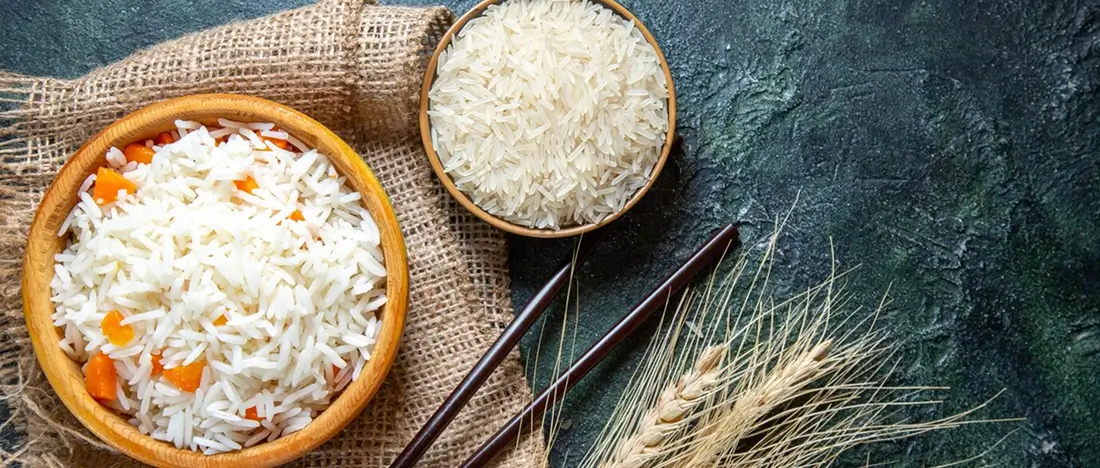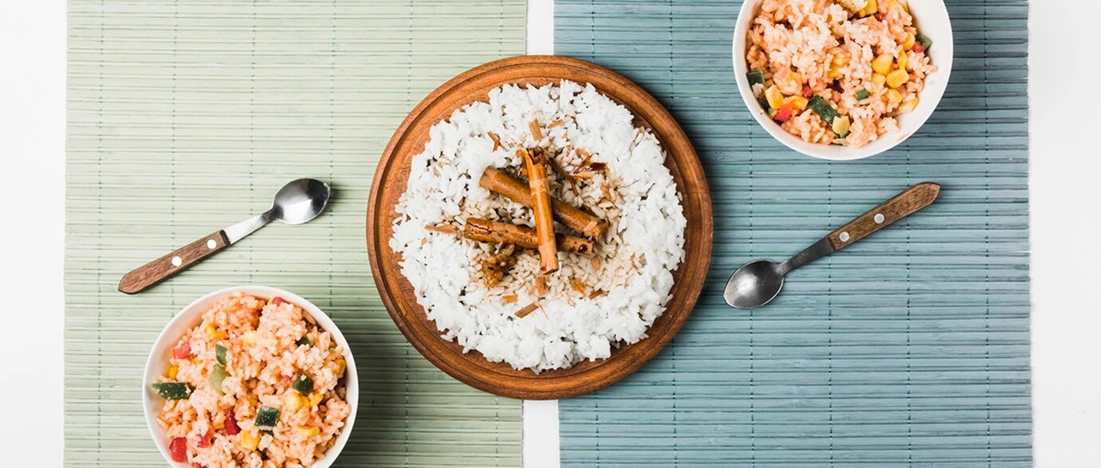Sona Masoori vs Basmati Rice – Which One is Best for Your Daily Diet?

Rice is the staple food for many people in India. It is the base of numerous drool-worthy dishes. The country is blessed with many types of rice. Sona Masoori and Basmati Rice are popular among all rice varieties because of their widespread use and unusual characteristics. Choosing one between these two can influence the texture and flavour of your meal as well as your nutritional profile. Hence, you are left wondering: Which is better, Sona Masoori or Basmati Rice? The blog is a comprehensive guide on Sona Masoori vs Basmati Rice that will help you select the right type of rice that best fits your kitchen and dietary needs. So, without any further delay, let’s begin!
What is Sona Masoori?
Sona Masoori is a medium-grained type of rice, especially grown in Andhra Pradesh, Telangana, and Karnataka. It is a hybrid rice variety derived from the cross-breeding of Sona and Masoori rice strains. Popular for being light and fragrant, it has a slightly sticky texture when cooked, which makes it versatile for many culinary creations, from daily steamed rice to special and mouthwatering dishes like lemon rice.

What is Basmati Rice?
Popularly known as the ‘Queen of Rice’, Basmati Rice is grown, especially along the Himalayan foothills. The unusual climate and soil of this region are responsible for its incredible qualities, making it distinctive. It is a long-grain rice celebrated for its needle-like grains that lengthen upon being cooked. Basmati rice is known to be fragrant and retains its fluffiness after cooking. The word Basmati itself means fragrant in Hindi, perfectly describing its signature aroma.

Sona Masoori vs Basmati Rice: The Comparison
Now that you know what the two varieties of rice are, let’s closely look at the differences between Sona Masoori and Basmati Rice. The differences between the two varieties of rice are discussed below:
1. Health Benefits
Sona Masoori Rice has fewer calories in comparison to Basmati Rice. It is packed with all the essential nutrients: carbohydrates, protein, dietary fibre, magnesium and iron, and vitamins like B6. It has a low glycemic index, which makes it ideal for individuals to manage blood sugar. Basmati Rice is richer in starch, carbohydrates, and calories in contrast to Sona Masoori. But it is packed with vital nutrients like folate, Vitamin B1, Vitamin B3, and iron.
2. Grain Size and Shape
When comparing Sona Masoori and Basmati rice, the grains of Sona Masoori are shorter and smaller. In contrast, Basmati rice has long and slender grains. This difference in shape and size influences the appearance and texture of the cooked rice.
3. Cooking Properties
Sona Masoori Rice gets cooked quickly and needs less water than Basmati Rice. On the other hand, Basmati Rice needs more attention to get the preferred texture and to keep the grains separated from each other. This is the reason Basmati Rice is soaked in water before cooking to enhance its texture.
4. Aroma and Flavour
In Sona Masoori vs Basmati Rice, Sona Masoori has a mild and gentle aroma, whereas Basmati Rice has a strong and unusual fragrance. When it comes to flavour, the former is subtle, whereas the latter has a tint of earthiness and sweetness.
5. Nutritional Content
Both Sona Masoori and Basmati Rice are rich in carbohydrates that give you energy. But what differentiates the two rice varieties based on nutrition is the starch content. Sona Masoori is regarded as healthier than Basmati Rice due to its low starch content. It is also easily digestible. In contrast, Basmati rice has a low glycemic index, making it a better choice for dietary requirements.
6. Culinary uses
Sona Masoori rice is especially used in cooking delicious South Indian dishes such as sweet pongal, vegetable pulao, and lemon rice. In contrast, Basmati Rice is especially favoured in cooking North Indian dishes such as pilafs, biryanis, etc.
7. Price and Availability
In Sona Masoori vs Basmati Rice, the latter, slightly more fragrant rice, is often more costly than the former because of its unusual ageing procedure. Its natural ageing enhances the flavour, scent and cooking attributes of Basmati Rice. It is available across the nation at all online stores and supermarkets. In contrast, Sona Masoori Rice is affordable than Basmati Rice. It is included as a part of daily meals. Sona Masoori is available throughout India.
| Aspect | Sona Masoori Rice | Basmati Rice |
|---|---|---|
| Health Benefits | Lower in calories & starch, high in fibre, vitamins & minerals | Richer in carbs & calories, contains folate, B1, B3, and iron |
| Grain Size & Shape | Shorter, smaller grains | Long, slender grains |
| Cooking Properties | Quick-cooking, uses less water | Needs soaking, requires attention for fluffy texture |
| Aroma & Flavour | Mild aroma, subtle flavour | Strong aroma, earthy-sweet flavour |
| Nutritional Content | Easily digestible, low starch, high in fibre | Low glycemic index, nutrient-rich, higher starch |
| Culinary Uses | South Indian dishes: Pongal, Pulao, Lemon rice | North Indian dishes: Biryani, Pilaf, Fried rice |
| Price & Availability | More affordable, widely available, everyday use | Premium-priced due to ageing, available in most markets |

Sona Masoori vs Basmati Rice: Which is a Better Choice for Your Daily Diet?
Sona Masoori and Basmati Rice are well-known rice varieties. The former is versatile, whereas the latter is mainly to elevate a meal. Sona Masoori has fewer calories than Basmati Rice. Thus, many people prefer to consume the former. You can cook multiple dishes with the help of Sona Masoori Rice, whereas Basmati Rice is typically used for cooking biryani, pilafs, and fried rice.
Basmati rice is a good choice to add flavour or elevate a meal. On the other hand, if you want to lose weight, Sona Masoori is a better option for daily consumption. This is due to its light and easily digestible chatracteristic. Choosing between Sona Masoori vs Basmati Rice is based on your taste, dietary habits and dish. However, taking a particular variety of rice is an individual preference. If you consume one kind of rice daily, you can take the other one for a change of taste. For example, if you eat Sona Masoori daily, you can have basmati rice twice or thrice a week.
Sona Masoori is apt for daily consumption, whereas Basmati Rice is ideal for occasional indulgence. Both varieties of rice have unusual flavours and textures that complement any dish.

Conclusion
To summarize, Sona Masoori and Basmati rice are nutritious and healthy. Both have unique health benefits and meet diverse culinary needs. You can effortlessly include them in your regular diet. When it comes to choosing Sona Masoori vs Basmati Rice, it depends on your preferences and requirements. The former has few calories and is light, which makes it ideal for daily consumption. On the other hand, the latter is aromatic, has more calories and carbohydrates, and the grain size is longer, making it perfect for special meals. Whether you prioritise health benefits or flavour, understanding the differences between Sona Masoori and Basmati Rice will help you choose the right variety of rice for your culinary creations. Are you searching for the best-quality rice? Choose the rice that you find is the best for you from Keshar Kali!
